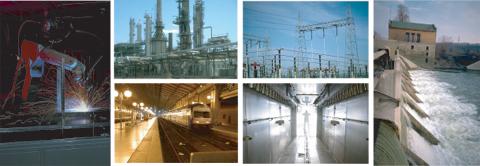Check out our White Paper Series!
A complete library of helpful advice and survival guides for every aspect of system monitoring and control.
1-800-693-0351
Have a specific question? Ask our team of expert engineers and get a specific answer!
Sign up for the next DPS Factory Training!

Whether you're new to our equipment or you've used it for years, DPS factory training is the best way to get more from your monitoring.
Reserve Your Seat TodayWhen it comes to first response units, specifically the police department, immediately responding to alerts is the difference between life and death. Integrating technology such as a SCADA (Supervisory Control and Data Acquisition) system is necessary.
SCADA is a system that consists of hardware and software components. These components allow you to monitor and control multiple processes throughout your facility. It can be found in municipalities, military bases, first response departments, college campuses, etc.

The main components of a SCADA system are the following:
Your SCADA system isn't likely to be monitored by one employee the entire time. This means there will be people with differing levels of familiarity looking at it. You must ensure that all your operators have the easiest time interacting with your SCADA system to promptly send out first response units to deal with time-sensitive calls.
This article will review the dos and don'ts when building or customizing your SCADA system.
A police station can not afford to have one of its SCADA systems go offline for even a second. In the unlikely event that it does, you need to be able to get back online as fast as possible. These failures can happen for reasons such as:
Standard practices are there to ensure you and your township's residents' safety. Deviating from these guidelines can cause severe consequences, such as:
When it comes to implementing or upgrading a SCADA system for your police department, it's crucial to avoid these mistakes and ensure the safety of your community. Keep your system maintained and stay compliant with regulations for efficient and effective emergency response.
The idea of a human being in charge of an automatic system might not make sense at first. That is until you find out about Text-2-Cell capabilities. A good SCADA system manufacturer will be able to help you install and configure a text-2-cell feature that would annunciate alarms from your RTU to your email or cellphone through a gateway. These messages are user-customizable and free of charge if done right.
This way you are not fully relying on an automatic system that will run rampant because nobody is constantly checking it to make sure it functions correctly. Instead of having someone in charge of your SCADA's maintenance onsite 24/7, you can have them get alerts straight to their phone with precise locations and information about what went wrong.
This means they don't need to waste trips going back and forth for the right tools to fix a problem.
SCADA integrates with surveillance cameras, sensors, and other types of inputs that are installed throughout a police station. A police station might benefit from BAS (building access system) that can monitor holding cells, access to evidence rooms, perimeter surveillance, etc.
To do this, make sure you can properly input your sensors and other inputs through analog and/or discrete inputs to your RTU. From there, a good RTU will decode this information and communicate it across a COMMON protocol.
Common communication protocols prevent your SCADA system from becoming obsolete due to not being able to communicate with equipment that is outside of your manufacturer's scope.
We previously discussed how you should take precautions in case of unforeseen events such as power outages. But what happens when an RTU fails to do its job?
This is why you need to have redundancy wherever it makes sense in SCADA. Take the following areas into consideration when looking to add redundancy:
In-depth documentation ensures that your in-house crew will be able to deal with your equipment in almost all situations. If that doesn't quite work for you, then make sure that your SCADA system manufacturer does on-site visits and tech support calls.
Tech support is arguably one of the most important yet overlooked requirements when people shop for SCADA systems. Having better tech support means successfully getting your system up and running if it ever goes down.
DPS Telecom does on-site visits to all clients that request it. We believe that it is a good foundation to truly understand your infrastructure, your needs, and the required SCADA configuration. We also provide our clients with in-depth documentation that offers a full guide on how to navigate and maintain our SCADA equipment.
DPS Telecom will back you with industry-tested expertise in tech support by people who pioneered the equipment being sold.
If you would like to learn more about how DPS Telecom can protect your monitoring and control capabilities, or if you have more questions, please reach out. Even if we can't find a compromise, I will do my best to point you in the right direction.
Call today at 1-800-693-0351 or E-mail me at sales@dpstele.com

Ziad Alezabi
Ziad Alezabi is a Application Documentarian at DPS Telecom. He reviews successful DPS client projects and reports on the best practices that you can use to successfully reach your own project goals.